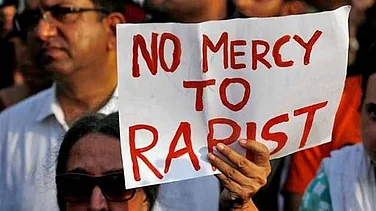In the morning as the villagers discovered the area littered with AK assault rifles, 9 mm pistols, anti-tank boosters, hand grenades, rocket launchers and a variety of deadly high-velocity weapons, they brought to light a shadowy gun-running business. It also put question marks on RAW and India's intelligence agencies.
But what was the mission of the AN-26 and its seven-member crew? Who financed it? Following the spectacular detaining of the plane at Bombay airport on December 22 and the interrogation of its crew, the Indian Government concluded it was a clear case of the ISI in action.
However, not everyone is willing to buy that theory. The manner in which the aircraft was permitted to fly unhindered on an uncharted route in an area regarded as high-surveillance, given the number of defence and civilian airports in the region, is suspicious. Purulia is not far from the sensitive Bagdogra airport or the RAW surveillance unit near Lucknow, in aeronautical terms within handshaking distance from Varanasi where the AN-26 landed.
Aviation and security officials have managed to draw up a flight plan of the arms-carrying cargo aircraft, which operated on the Karachi-Varanasi-Calcutta-Phuket route. Aviation officials say that on the Varanasi-Calcutta sector, the aircraft was flying low enough not to be on the radar monitors. After dropping the arms, the plane left Phuket for Karachi. It obtained permission to refuel at Calcutta but instead of landing there, it headed for Madras. As it touched down at Madras airport on December 21, an IAF surveillance unit noticed the violation. But before the Madras Air Traffic Control (ATC) could be alerted, the plane had taken off and the IAF contacted its air bases and civilian ATCs. Meanwhile, two IAF MiGs from the Bhuj air base in Gujarat were put into action and forced the airplane to land at Bombay. Six crew members were detained while one strolled out of the airport. The detainees have now been formally arrested and charged with waging war against the state.
The ammunition airdropped by the chartered AN-26 was packed in boxes, which reportedly carried Latvian or East European markings. There were as many theories on the origin of the consignment as there were on its final destination. Purulia is located at the crucial tri-junction of West Bengal, Bihar and Assam. And the authorities in the three states had their own assessments. The West Bengal government hinted at the involvement of Anand Margis and have now arrested five abadhuts (monks) in Purulia district in connection with the airdropping of arms. Bihar said the arms may have been meant for the flourishing private armies and Naxalites in its southern territory neighbouring West Bengal; and the Assam government suggested that the arms cache was meant for insurgents in the North-east.
But what really baffled the security agencies was the sheer volume of the arms dropped. For three days running, AK assault rifles and rocket launchers were strewn around, especially in the Jhalda and Jaipur police stations of the district, and villagers were told to deposit any arms they chanced upon. The weapons turned up in all kinds of places, from bushes and dry ravines to roadsides and backyards of mud homes.
Meanwhile, on December 22, after IAF fighters forced the unidentified plane to land at Bombay, it became apparent that the canvas of investigations and its impli-cations were much wider than was earlier thought. Six crew members—five Russians of Latvian origin identified as Captain A. Klishn, O. Gaidash, I. Moskuitan, I. Timm-erman and E. Antimenko and a former British military intelligence officer, Peter K. Bleach—were taken into custody. But the seventh man, Kim Peter Davy, a New Zealander who was reportedly the financier, got away from one of the exits at the airport.
Apart from the six crew members, the authorities are also interrogating the owner of the New Delhi-based air charter service, whose director J.S. Malhan sought permission from the DGCA for the flight that originated in Karachi on December 17. According to security officials, the company is working on behalf of Carol Airlines, a UK-based firm, which owns the seized AN-26.
By December 23, the Intelligence Bureau, RAW, the CBI and other security agencies had extracted some confessions. The crew admitted to having dropped the arms and said they had used three parachutes for the purpose. And as they revealed they were based in Karachi for the last two months, the Pakistani and ISI theory got a boost.
So how did their airplane traverse across the country, drop the arms in West Bengal and land in Madras? According to Director General of Civil Aviation H.S. Khola, permissions are granted every day to civilian planes flying over India and touching down only to re-fuel. "They have to formally apply with passports, details of the crew, type of aircraft and flying licences and an air corridor is allotted to them," he says. But the Russian plane obviously deviated from its allotted course and would have got away, had it not been for the alert IAF surveillance unit in Madras.
There are still too many loose ends. If a formal permission had been applied for, with all relevant papers, then how is that the crew arrested in Bombay had no papers on them, not even their Pakistani visas and passport documents. More importantly, the ATCs, meant to monitor all flights on a second-to-second basis, seem to have no idea where the aircraft proceeded to from Calcutta. From the moment an aircraft enters Indian airspace, the ATCs monitor its entire route. Ordinarily, if an aircraft is lost on the radar monitor for more than five minutes, a rescue operation is launched. In this case, the flight was untraced for three hours on December 17 as it supposedly flew to Varanasi, a distance covered in less than 45 minutes. Investigators say this was the time the aircraft required for a detour to Purulia.
Some newspaper reports also suggest that when the plane landed at Varanasi on December 17, a "middle-aged man", identified as Kim Davy, got off the aircraft to pay for the aviation fuel. And since it was a Sunday, bank personnel were specially summoned for the transactions as the payment wasn't being made in Indian currency. A clear indication that the crew was well-connected.
Within hours of the arrest, the ISI hand was thrown at the media. According to Bombay Police Commissioner R.D. Tyagi, the crew confessed to be mercenaries on the pay-roll of the ISI. More importantly, he added that the crew had conducted a dry run on the same route between November 21 and 24 in which Bleach, the British member of the crew, was involved.
But at the end, some significant questions remain: is the aircraft linked to the arms dropping at all? Could it be a RAW operation gone sour? Security officials point out that if RAW was involved, the plane would have been allowed to get away. They also say that RAW would normally not supply arms to the Chakmas because the tribals aren't powerful enough to take on the Bangladesh army.
On the other hand, they say the ISI is known to supply arms to extremists in the North-east, including the Bodos, the NSCN and ULFA, and has a strong presence in Nepal and Bangladesh. Latvian crew were used to make it difficult to trace the arms' origin.
And the dry run theory only makes the intent of rival intelligence agencies more confusing. At two separate meetings convened by senior Home Ministry officials last week, concern was expressed at the lack of air surveillance on the country's sensitive nuclear installations at Narora and Kalapakkam. Security agencies are also probing the theory that the aircraft may have been used to transport drugs to the Golden Triangle, as it was stationed at Phuket in Thailand.
Moreover, the arrested crew's line that they had sought permission to land in Myanmar has been disclaimed by Rangoon authorities. Hopefully, Union Home Secretary K. Padmanabaiah, currently in Myanmar to discuss other border issues, will find clues to the mystery. Till then, it will remain a proverbial case of truth being stranger than fiction.






















